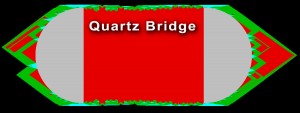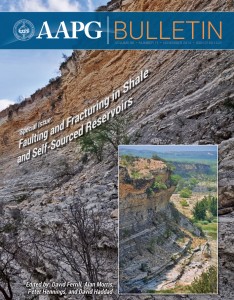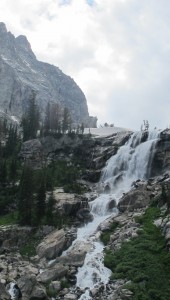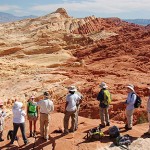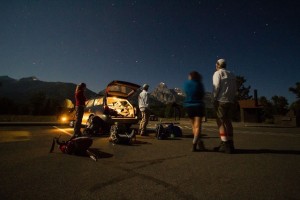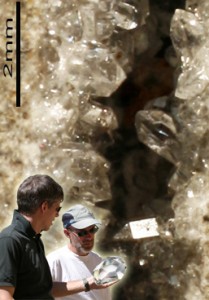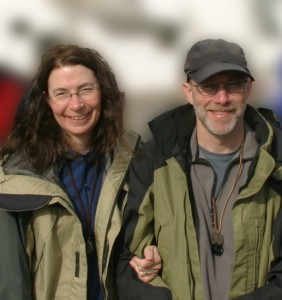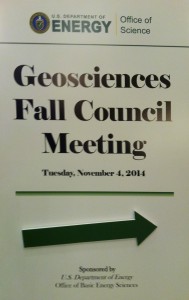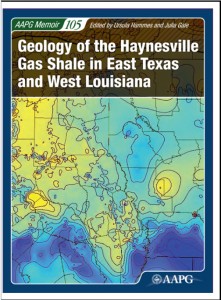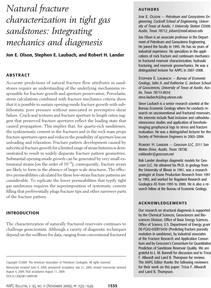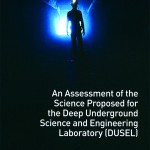News
2024 Highlights
Fractures and landforms | The paper Introducing standardized field methods for fracture-focused surface processes research was published in Earth Surface Dynamics. Many approaches developed in our program are featured. | Read the paper
Events | The 2024 Annual Review meeting for FRAC is set for October 7-8 in Austin, Texas. Contact Julia Gale for more information.
2023 Highlights
Awards | PhD Student Stephanie Forstner has been awarded a 2023-2024 Endowed Presidential Scholarship. Congratulations.
Hot papers | In September, several project papers in Journal of Structural Geology have been recognized by the publisher for high download numbers in the past 90 days. These numbers indicate interest in our work.
No. 1. Fracture pattern growth in the deep, chemically reactive environment, Hooker et al., 2023 | view
No. 3. Scale-dependent fracture networks, Forstner & Laubach, 2022 | view
No. 5. Microfractures: a review, Anders, Laubach, Scholz, 2014 | view
In the top ten last month: Rigorizing the use of the coefficient of variation to diagnose fracture periodicity and clustering, Hooker, Marrett, Wang | view
Ultra-deep basins | Our lead-off introductory paper to the special issue of the Journal of Structural Geology on brittle deformation in deep and ultra-deep basins is published. The entire issue will be open access for the next six months.
- Laubach, S.E., Zeng, L., Hooker, J.N., Wang, Q., Zhang, R.H., Wang., J., Ren, B., 2023. Deep and ultra-deep basin brittle deformation with focus on China. Journal of Structural Geology 175, 104938 | view at publisher
Way points | Qiqi Wang and Rodrigo Corrêa both successfully defended their dissertations this summer. Congratulations.
Award | S.E. Laubach was recognized with the JSG Joseph C. Walter, Jr., Excellence Award, the Jackson Schools highest honor.
Highly cited | According to ISI Web of Science, as of March 2023, three project papers are recognized as ‘highly cited’ having received enough citations to place them in the top 1% of their academic field based on a highly cited threshold for the field and publication year:
- Laubach, S.E., Lander, R.H., Criscenti, L., et al. 2019, The role of chemistry in fracture pattern development and opportunities to advance interpretations of geological materials. Reviews of Geophysics 57 (3), 1065-1111. doi:10.1029/2019RG000671 | Link
- Gale, J.F.W., Laubach, S.E., Olson, J.E., Eichhubl, P., and Fall, A., 2014, Natural fractures in shale: a review and new observations. AAPG Bulletin 98, (11), 2165-2216. doi: 10.1306/08121413151 | Link
- Anders, M.H., Laubach, S.E., and Scholz, C.H., 2014, Microfractures: a review. Journal of Structural Geology 69, Part B, 377-394. | Link
More on the BEG site: top cited papers
Recognition | A project paper was recognized as first runner up for the 2022 Bureau of Economic Geology Best Paper Award: Gale, J.F.W., Fall, A. Yurchenko, I.A., Ali, W.A., Laubach, S.E., Eichhubl, P., & Bodnar, R.J., 2022. Opening-mode fracturing and cementation during hydrocarbon generation in shale: An example from the Barnett Shale, Delaware Basin, West Texas. AAPG Bulletin 106(10), 2103-2141. doi:10.1306/01062219274 | view at publisher
Popular articles | As of January 12, two SDI student-authored papers are on the top ‘most downloaded’ articles in the past 90 days at Journal of Structural Geology. The papers are ‘Scale-dependent fracture networks’ by Stephanie R. Forstner and S. E. Laubach [download the paper] and ‘Analysis of spatial arrangement of fractures in two dimensions using point process statistics’ by Rodrigo S. M. Corrêa, R. Marrett, and S. E. Laubach [download the paper]. At number 1 and 3 respectively. Congratulations on the buzz.
Featured research | Julia Gale, Sara Elliott, Bethany Rysak, and Steve Laubach co-authored a paper detailing the critical role of core in understanding hydraulic fracturing that was featured in Science Letter. The research on direct observation of hydraulic fractures is a key part of our program. The paper is in Geological Society of London Special Publications 527 | view at publisher
Top cited in past 5 years–Journal of Structural Geology | According to Google Scholar, over the past five years four project papers are among the top cited works in Journal of Structural Geology:
- Laubach, S.E., Lamarche, J., Gauthier, B.D.M., Dunne, W.M., and Sanderson, D.J., 2018. Spatial arrangement of faults and opening-mode fractures. Journal of Structural Geology 108, 2-15. doi.org.10.1016/j.jsg.2017.08.008 | view at publisher
- Marrett, R., Gale, J.F.W., Gomez, L., and Laubach, S.E., 2018. Correlation analysis of fracture arrangement in space. Journal of Structural Geology 108, 16-33. doi.org/10.1016/j.jsg.2017.06.012 | view at publisher
- Hooker, J.N., Laubach, S.E., and Marrett, R., 2018. Microfracture spacing distributions and the evolution of fracture patterns in sandstones. Journal of Structural Geology 108, 66-79. doi.org/10.1016/j.jsg.2017.04.001 | view at publisher
- Li, J.Z., Laubach, S.E., Gale, J.F.W., and Marrett, R., 2018. Quantifying opening-mode fracture spatial organization in horizontal wellbore image logs, core and outcrop: application to Upper Cretaceous Frontier Formation tight gas sandstones, USA. Journal of Structural Geology 108, 137-156. doi.org/10.1016/j.jsg.2017.07.005 | view at publisher
Top cited in past 5 years–Petroleum Geoscience | According to Google Scholar, over the past five years a project paper is among the top cited works in Petroleum Geoscience:
- Wang, Q., Laubach, S.E., Gale, J.F.W., and Ramos, M.J., 2019. Quantified fracture (joint) clustering in Archean basement, Wyoming: application of Normalized Correlation Count method. Petroleum Geoscience, 25, 415-428. doi:10.1144/petgeo2018-146 | view at publisher
2022 Highlights
Recognition | Rodrigo S. M. Corrêa, PhD candidate in the Structural Diagenesis program, has been awarded a prestigious Endowed Presidential Scholarship for 2022. Rodrigo’s dissertation research addresses chemical and mechanical process influencing fracture spatial arrangement in carbonate rocks. The work is supervised by S.E. Laubach. Rodrigo recently published accounts of fracture development in a fault zone in Marine & Petroleum Geology (see paper) and a new method and software to analyze 2D spatial arrangement in Journal of Structural Geology (see paper).
New Papers | Scale-dependent fracture networks by Stephanie R. Forstner and S. E. Laubach was recently accepted for publication in Journal of Structural Geology. The paper describes how diagenesis imposes a scale on open fracture networks, and describes a new approach to characterizing fracture network connectivity that takes scale into account. | view at publisher
Penrose Conference: Progressive Failure of Brittle Rocks | S.E. Laubach, Member, International Advisory Panel and Keynote Speaker. | About the lecture | For more meeting information. June 20-24, Flatrock, NC
Recognition | S. E. Laubach was recognized by the American Geophysical Union for outstanding service in peer review for the journal Reviews of Geophysics. | Read the AGU announcement
Deep and ultra-deep basin brittle deformation | Theme issue, Journal of Structural Geology, inviting contributions. Editor S.E. Laubach and guest editors: John N. Hooker, Qiqi Wang, Lianbo Zeng, András Fall, Ronghu Zhang, and Bo Ren, | For more information
Faculty award | SDI collaborator John N. Hooker, assistant professor of Environmental Science at UIW, was awarded the 1881 Commemorative Award for Faculty Development by the Faculty Research Award Committee. The 1881 Commemorative Award for Faculty Development Fund was established to celebrate 1881, the founding year of UIW, and to encourage faculty development. The goal is to foster professional development for faculty and to recognize the leadership of a faculty member in relation to the University’s Mission. Hooker will apply the priciples of structural diagenesis to study accelerating mineral CO2 sequestration.
2021 Highlights
Best of Petroleum Geoscience Collection | Qiqi Wang et al.’s paper is included in the Geological Society’s 2021 Best of Petroleum Geoscience Collection. Quantified fracture (joint) clustering in Archean basement, Wyoming: application of Normalized Correlation Count method appreared in Petroleum Geoscience, 25, 415-428. doi:10.1144/petgeo2018-146 | view at publisher
Student Research Symposium Award | Honorable mention: Bethany Rysak | Title: Analysis of Hydraulic Fracture Growth and Segmentation: Implications of Observations From the HFTS1 Slant Core, Wolfcamp Fm., Midland Basin, West Texas
Qualifying Exams | Congratulations to B.T. Lee, Rodrigo Correa, and Stephanie Forstner, all of whom recently passed their Ph.D. qualifying exam.
2020 Highlights
Description of UT fracture program | An article in the JSG Newsletter describes the history and accomplishments of our fracture research program. Read the article
Annual Meeting 2020 | The Structural Diagenesis Initiative/Fracture Research & Application Consortium annual meeting was held virtually from November 9-10 plus associated short courses. Contact Julia Gale for more information.
Impact paper | No. 5 on ‘Most Read’ list, November 2020, according to publisher: The nature and origins of decameter-scale porosity in Ordovician carbonate rocks, Halahatang oilfield, Tarim Basin, China by Ukar, E., Baqués, V., Laubach, S.E., Marrett, R. Journal of the Geological Society, 177, 1074-1091. doi:10.1144/jgs2019-156, 2020. | view at publisher
Modeling fracture pattern development | Byungtark (B.T.) Lee is a new Ph.D student in PGE working with J.E. Olson. His research is Natural Fracture Pattern Development Using 3D Displacement Discontinuity Method Coupling with Structural (or Chemical) Diagenesis Process | background information
Keynote lecture | Importance and applications of diagenesis in naturally fractured reservoirs, Esti Ukar, 4th EAGE Naturally Fractured Reservoir Workshop, UAE, 11 February.
2019 Highlights
The Role of Chemistry in Fracture | A review of the role of chemistry in fracture pattern development and of prospects for future research was recently published in Reviews of Geophysics. As a prestigious review publication by invitation only, Reviews of Geophysics provides a comprehensive overview of geophysics research.
Fracture pattern development has been a challenging area of research in the earth sciences for more than 100 years. A new article in Reviews of Geophysics describes how future advances will require new approaches based on a chemical perspective.
Fracture pattern development has been a challenging area of research in the earth sciences for more than 100 years. Much has been learned about the spatial and temporal complexity inherent to these systems but severe challenges remain. The article in Reviews of Geophysics describes how future advances will require new approaches based on a chemical perspective. Chemical processes play a larger role in opening-mode fracture pattern development than has hitherto been appreciated. A chemical perspective helps solve challenges to understanding subsurface fractures, including how to better use limited subsurface samples, how to interpret ambiguous outcrop analogs, and how to overcome difficulties determining which models are correct from observations. The paper describes how many tools of chemical analysis, experiment, modeling and theory can be brought to bear on understanding how fracture patterns develop at geological time scales. A major conclusion is that chemical and mechanical investigations together have great potential to solve challenging practical problems in subsurface science.
Laubach, S.E., Lander, R.H., Criscenti, L.J., et al., 2019. The role of chemistry in fracture pattern development and opportunities to advance interpretations of geological materials. Reviews of Geophysics, 57 (3), 1065-1111. doi:10.1029/2019RG000671 | view at publisher | blog post | AGU editor’s Vox | JSG press release
New papers in Petroleum Geoscience | Two project papers were recently published in the Geological Society of London’s prestigious journal Petroleum Geoscience.
- Weisenberger et al. describe a process by which calcite contained in sandstone host rock is mobilized and re-precipitates as carbonate cement within a certain temperature range in fractures wider than 1 mm. This process can be predicted based on how certain minerals are distributed within the host rock and, hence, provides an opportunity to forecast whether fractures are hydraulically sealed or open | view
- The paper by Wang et al. focuses on crystalline basement and quantifies spatial arrangements of fractures and joints mapped in the Teton Range (Wyoming, USA). With the help of intensity plots as well as the new correlation count method self-organized fracture clusters can be discerned over a wide range of length scales. The paper illustrates how the new method provides the means to greatly improve fracture permeability models and make flow simulations more robust | view
Best Student Author of the Year | On November 1 at The Independent in downtown Austin, in his capacity as North American Editor for Journal of Structural Geology, Steve Laubach presided over awarding Natalie Debenham the journal’s Best Student Author of the Year award for 2019. Natalie recently completed a Doctor of Philosophy in structural geology and petroleum geoscience at the Australian School of Petroleum (The University of Adelaide). Her research was focused on using natural fracture networks to predict subsurface fluid flow in Australia’s petroleum producing basins. The award, from the leading international journal in the field of structural geology, is for her 2018 paper entitled ‘The influence of a reverse-reactivated normal fault on natural fracture geometries and relative chronologies at Castle Grove, Otway Basin.’ | Blog post | For more information about the author
Citations impact | Recent papers having an impact as measured by citations are tracked by Google Scholar. According to the September 2019 Google Scholar h-5 index for 2014-2018 for these leading journals in our field, 12 initiative papers are recognized as highly cited:
Geological Society of America Bulletin
- #1 Insights into rates of fracture growth and sealing from a model of quartz cementation in sandstone, 2015. By Lander, Laubach | view
- #19 Natural hydraulic fracturing of tight-gas sandstone reservoirs, Piceance basin, Colorado, 2015. By Fall, Eichhubl, Bodnar, Laubach, Davis: | 2016 Tinker Family Publication Award, BEG | view
- #21 A universal power-law scaling exponent for fracture apertures in sandstones, 2014. By Hooker, Laubach, Marrett | view
SPE Journal
- #1 Simultaneous multifracture treatments: fully coupled fluid flow and fracture mechanics for horizontal wells, 2015. By Wu, Olson | view
- #4 How natural fractures could affect hydraulic fracture geometry, 2014. By Taleghani, Olson | view
SPE Production & Operations
- #2 Numerical investigation of complex hydraulic fracture development in naturally fractured reservoirs, 2016. By Wu, Olson | view
- #3 Numerical analysis for promoting uniform development of simultaneous multiple-fracture propagation in horizontal wells, 2017. By Wu, Olson, et al. | view
AAPG Bulletin
- #1 Natural fractures in shale: A review and new observations, 2014. By Gale, Laubach, Olson, Eichhubl, Fall | Web of Science Highly Cited paper | view
Journal of Structural Geology
- #3 Microfractures: A review, 2014. By Anders, Laubach & Scholz | view
- #36 Spatial arrangement of faults and opening-mode fractures, 2018. By Laubach, Lamarche, Gauthier, Dunne | view
- #37 Correlation analysis of fracture arrangement in space, 2018. By Marrett, Gale, Gomez, Laubach | view
Geological Magazine
- #14 Fracture porosity creation and persistence in a basement-involved Laramide fold, Upper Cretaceous Frontier Formation, Green River basin, USA, 2016. By Laubach, Fall et al. | view
Hydraulic fracture | Julia Gale is featured in a news article about research based on the Hydraulic Fracture Test Site. View news article. A 2018 article by Gale et al. describing fracture patterns in the HFTS core has gotten a lot of attention from the engineering community and is being widely cited. View the Gale et al. paper
Invited Talk China | P. Eichhubl presented Natural Fracture Characterization and Prediction to RIPED in Beijing, China, on October 28
Awards | Jon Olson has been recognized with the SPE Completions Optimization and Technology Award. He was also presented with the Regional Distinguished Achievement Award for Petroleum Engineering Faculty for the Southwestern North America region. Also for the southwestern SPE region, Masa Prodanovic earned the Regional Formation Evaluation Award. Peggy Rijken, a Ph.D. graduate of our program, was recognized with a Distinguished Membership. Chris Hilgers, our collaborator at Karlsruhe Institute of Technology, earned the South Central and Eastern Europe Region Regional Distinguished Achievement Award for Petroleum Engineering Faculty.
Keynote | Peter Eichhubl presented a keynote address to the SEG Fractured Reservoir and Unconventional Resources Forum. The meeting was held 1-3 September in Lanzhou, China. Eichhubl and Laubach were members of the meeting Technical Committee.
SPE Conference Leadership | PGE and FRAC alum Dr. Peggy Rijken is ATCE 2019 Program chairperson. The 2019 SPE Annual Technical Conference & Exhibition will be in Alberta, Canada 30 September to 2 October. In 2015 Dr. Rijken was honored as a Distinguished Alumna of PGE. While working at UT in the SD Initiative, Rijken did important work on fracture pattern development, fracture height growth, the effects of diagenesis on subcritical crack index, and incorporation of fractures into fluid flow simulation. Her 2005 dissertation Modeling naturally fractured reservoirs: from experimental rock mechanics to flow simulation was widely considered to be a benchmark contribution. An early adopter of the concept of ‘structural diagenesis’, her 2002 GCAGS paper on predicting natural fractures using mechanical modeling and diagenesis is highly cited. Rijken has been with Chevron since graduation. View dissertation | View GCAGS paper
The Complete Mechanics or the Complete Chemistry? | S. E. Laubach, presented at AAPG Petroleum Structure & Geomechanics Division Annual Meeting, San Antonio, Texas, May 21.
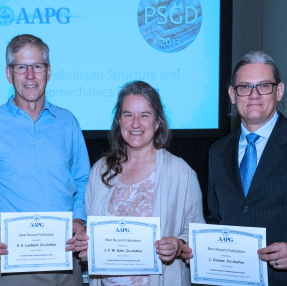
Best paper Award
Best Paper Award | An initiative paper received the AAPG Petroleum Structure & Geomechanics Division Best Recent Paper Award at the 2019 ACE meeting in San Antonio in May. The paper, Correlation analysis of fracture arrangement in space was published in the March 2018 issue of Journal of Structural Geology. Authors are Marrett, Gale, Gomez, and Laubach. Information about the Division event can be found here.
The paper makes the case that fracture or fault spacing does not effectively characterize overall pattern arrangement, and that new approaches are needed to address this fundamental aspect of fracture and fault patterns. The paper describes new principles and a route to apply the principles to solve a major practical challenge in subsurface geoscience. | view paper | notice on J. Struct. Geol. site | read the blog |
SDI Initiative at ACE | In addition to the Best Paper Award event at the Petroleum Structure & Geomechanics Division meeting, Structural Diagenesis Initiative scientists are involved in leadership and presentations at the AAPG Annual Convention in San Antonio. For schedule, venue, and presentation highlights, see Event Details
For the 2020 ACE, Esti Ukar is on the Petroleum Structure & Geomechanics Division committee planning and reviewing submissions for structure and geomechanics sessions.
Impact papers | Initiative papers Correlation analysis of fracture arrangement in space by Marrett et al. [view] and Quantifying opening-mode fracture spatial organization in horizontal wellbore image logs, core and outcrop by Li et al. [view] are among the most cited articles published in Journal of Structural Geology since 2016 according to the publisher. The 2019 paper in Petroleum Geoscience by Qiqi Wang et al. [view] is also one of the three most downloaded articles of Spring-Summer 2019 accoding to the publisher.
Promotion | Andras Fall has been promoted to Research Scientist at the Bureau of Economic Geology.
Fellowship Award | Qiqi Wang has received a fellowship from the Geology Foundation of the Jackson School of Geosciences in support of her 2019 dissertation field work.
Student Award | Natchanan ‘Mint’ Doungkaew received a GSA Graduate Student Research Award in support of her PhD research project on Fracture Growth in Chemically Reactive Systems.
Solid Earth Special Issue | Peter Eichhubl is one of the guest editors for a special issue of the journal Solid Earth that will cover ‘Faults, fractures, and fluid flow in the shallow crust’. Submissions are open until February 2010.
Editorial board service | Esti Ukar has been appointed to the Board of Associate Editors for AAPG Bulletin. She joins Andras Fall and Julia Gale of the SD initiative on the board.
Invited Talk Vienna | Peter Eichhubl presented Fracture Research on Sandstone to OMV in Vienna, Austri, on March 5.
New FI paper ‘Most Read’ | According to the publisher, Fall & Bodnar 2018 is the number 1 most read paper in Economic Geology in February 2019. | read the paper | read the blog post
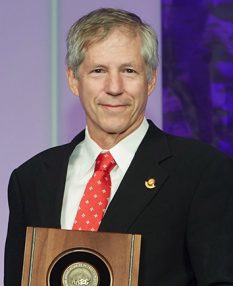 North American Editor Journal of Structural Geology | S.E. Laubach is the new North American Editor for Journal of Structural Geology, taking over from William M. Dunne. Laubach joined JSG’s Editorial Advisory Board in 2012. He has edited two special issues for the journal: in 2010, Structural Diagenesis and in 2018, Spatial arrangement of fractures and faults. During the past 40 years, the Journal of Structural Geology has acted as the main vehicle for the dissemination of studies on the fundamentals and processes of structural geology. | Editorial | visit the Journal
North American Editor Journal of Structural Geology | S.E. Laubach is the new North American Editor for Journal of Structural Geology, taking over from William M. Dunne. Laubach joined JSG’s Editorial Advisory Board in 2012. He has edited two special issues for the journal: in 2010, Structural Diagenesis and in 2018, Spatial arrangement of fractures and faults. During the past 40 years, the Journal of Structural Geology has acted as the main vehicle for the dissemination of studies on the fundamentals and processes of structural geology. | Editorial | visit the Journal
Mature Fields in México | The Society of Petroleum Engineers (SPE) workshop was held February 18-19 in Villahermosa. S.E. Laubach was on the organizing committee and participated in the wrap-up panel discussion. SDI collaborator Wayne Narr also presented.
New members of SDI community | Nicola Tisato of UT’s Department of Geological Sciences and Michael Pyrcz of Petroleum & Geosystems Engineering will be collaborating more closely with the Structural Diagenesis Initiative. We look forward to working with them, and to the insights into experimental rock physics and rock mechanics and integrated characterization and statistics they bring to our mission. More information about Tisato’s research | More information about Pyrcz’s research.
Visiting Scientist | Shan Xiang will be a visiting scientist with our initiative for one year. From the PetroChina Hangzhou Research Institute of Geology, Shan specializes in diagenesis. He will be working with us expanding his perspective on structural diagenesis.
Project papers attracting attention | Three project papers published in the Journal of Structural Geology have been noted by the publisher for being among the ‘most downloaded’ in the past 90 days.
- Microfractures: a review | Anders, Laubach & Scholz. From December 2014, this paper is number 3 on the most downloaded list; also number 3 on the ‘most cited’ list | view
- Spatial arrangement of faults and opening-mode fractures | Laubach & others. From March 2018, this paper is number 5 on the most downloaded list | view
- Correlation analysis of fracture arrangement in space | Marrett & others. From March 2018, this paper is number 8 on the most downloaded list | view
Qualifying exam | Qiqi Wang passed her qualifying exam on January 24th.
Hydraulic fracture & proppant | Sara Elliott and Julia Gale’s research describing direct observations of proppant in hydraulic fractures is highlighted in the December issue of The American Oil & Gas Reporter. | view at publisher
AAPG conference leadership | SDI collaborator Peter Hennings is the Technical Program Chair for the 2019 AAPG Annual Convention, to be held 19-22 May, 2019, in San Antonio. | visit the ACE2019 site
Citation recognition for Gale et al. 2014 | According to Web of Science, as of November/December 2018, this highly cited paper received enough citations to place it in the top 1% of the academic field of Geosciences based on a highly cited threshold for the field and publication year. Gale, J. F. W., Laubach, S. E., Olson, J. E., Eichhubl, P., and Fall, A., 2014. Natural fractures in shale: a review and new observations. AAPG Bulletin 98 (11), 2165-2216. doi: 10.1306/08121413151 | view | blog post
2018 Highlights
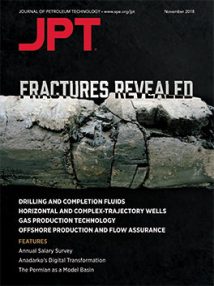 Fractures Revealed | The November issue of SPE’s Journal of Petroleum Technology prominently features project research. News articles describe our research on fractured upper and middle Wolfcamp in West Texas.
Fractures Revealed | The November issue of SPE’s Journal of Petroleum Technology prominently features project research. News articles describe our research on fractured upper and middle Wolfcamp in West Texas.
Initial results of this multi-year study were reported at this year’s Unconventional Resources Technology Conference (UrTec). Julia Gale provided the journal cover illustration of hydraulically fractured shale recovered in long cores from the Permian Basin. Links here for access to JPT and to the lead-off UrTEC paper, Gale et al. 2018
Council on Chemical Sciences, Geosciences, and Biosciences | On November 6, Council member S.E. Laubach participated in a council meeting in the Washington DC area. The council seeks topics for workshops that address key fundamental scientific questions where a cross disciplinary workshop and resulting paper have the potential to influence a field. Areas of investigations that have experienced recent developments or discoveries that would make a workshop timely are of particular interest. Contact S.E. Laubach if you have ideas that might fit these criteria.
Shale Geophysics Publications | Two benchmark papers on shale properties by M.J. Ramos and colleagues have recently been published in Geophysics and in Geophysical Journal International. The papers describe quantifying static and dynamic stiffness anisotropy and microstructural controls on elastic anisotropy. For more information see Publications 2019.
SDI Student Event & FRAC Picnic 2018 The event is scheduled for Saturday, November 17th. This is an event for students, alumni, staff, faculty, and our industry colleagues and their families and we hope friends of structure and diagenesis can join us. The lake is full! Contact Steve Laubach for details.
London keynote address | At the Geological Society of London‘s historic home in Burlington House, London, S.E. Laubach delivered the lead-off keynote address for the October 24-25 conference The Geology of Fractured Reservoirs. The lecture, Fracture Corridors and Structural Diagenesis, reviewed themes from recent Structural Diagenesis Initiative research. Contact Laubach if you need more information.
New overview paper on fluid inclusion assemblages | András Fall and Bob Bodnar have an important new paper forthcoming in the journal Economic Geology. The paper ‘How precisely can the temperature of a fluid event be constrained using fluid inclusions?’ determines the acceptable ranges of homogenization temperatures for a wide range of geologic environments. The paper is likely to be the standard reference for fluid inclusion work going forward. | view
Field studies Neuquén | In October, Ukar and Gale, along with collaborating YPF researchers and field assistants, conducted field work in the Lajas Formation sandstone outcrops in the Neuquén Basin, Argentina. The Lajas Formation is an important producing tight gas sandstone. The field work is part of our ongoing field studies in Argentina and Bolivia. Results on recent work in the Vaca Muerta are reported on the Publications page. A research group meeting in Argentina is being contemplated.
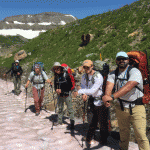 Annual Research Review and Field Trips | The SDI and FRAC annual research review meeting was held September 18 and 19 in Casper, Wyoming. Jon Olson and Peter Hennings led a pre-meeting field trip, and Steve Laubach and Julia Gale, Peter Eichhubl, and Qiqi Wang led two separate post-meeting trips based out of Jackson Hole, Wyoming. Laubach’s post-meeting trip re-traced this past summer’s traverse of the Teton Range, and viewed regional and fault-related fractures in basement rocks and overlying sandstones. For more information, contact Steve Laubach.
Annual Research Review and Field Trips | The SDI and FRAC annual research review meeting was held September 18 and 19 in Casper, Wyoming. Jon Olson and Peter Hennings led a pre-meeting field trip, and Steve Laubach and Julia Gale, Peter Eichhubl, and Qiqi Wang led two separate post-meeting trips based out of Jackson Hole, Wyoming. Laubach’s post-meeting trip re-traced this past summer’s traverse of the Teton Range, and viewed regional and fault-related fractures in basement rocks and overlying sandstones. For more information, contact Steve Laubach.
Gordon Conference | Peter Eichhubl was a discussion leader at the Gordon Research Conference on Rock Deformation Integrated Approaches to Rock Deformation: Observations, Experiments, and Models held August 19-24, 2018, at Proctor Academy, Andover, New Hampshire, USA
Project research featured in AAPG Explorer | The August 2018 AAPG Explorer highlights the research of our former Ph.D student Arash Dahi and his advisor Jon Olson. ‘Understanding the interplay of natural and induced fractures’ (p. 12) outlines experimental and theoretical work on how pre-existing fractures affect hydraulic-fracture geometry and how seismic can be used for post-treatment analysis. Dahi is currently a professor at Penn State. For some of our recent work on this topic, see the 2018 publications list.
Hydraulic Fractures in Core | The URTEC paper Hydraulic Fractures in Core From Stimulated Reservoirs: Core Fracture Description of HFTS Slant Core, Midland Basin, West Texas by J.F.W. Gale, S.J. Elliott and S.E. Laubach is available online. View
Presentation at BES Principal Investigators meeting | On August 9, S.E. Laubach presented “Chemical-mechanical interaction in development of fracture size and spatial arrangement” at the Basic Energy Sciences Principal Investigators meeting in Gaithersburg, MD
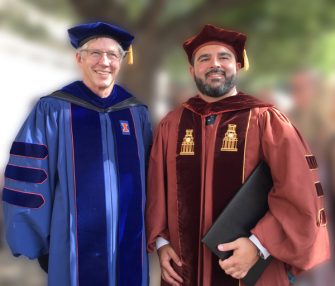
S.E. Laubach & M.J. Ramos
Karlsruhe Institute of Technology | S.E. Laubach visited KIT in July and August and participated in Ivy Becker’s successful dissertation defense. On August 1 Laubach presented results of project research to KIT staff and students.
UT Dissertation Defenses | Matt Ramos, Owen Callahan and Jon Major all successfully defended their dissertations in July and August.
Field studies | Stephanie Forstner, Qiqi Wang and Matt Ramos, along with S. E. Laubach, and assisted by Finn Tierney, a fellowship undergraduate from Carlton, successfully carried out field work in Utah and Wyoming in July.
AGU Session on Fracture Processes in Chemically Reactive Subsurface Environments
Organized by John N. Hooker and Peter Eichhubl, Session To20 will be held during the AGU Fall Meeting in Washington D.C., 10-14 December, 2018. The submission deadline is August 1.
Notable project papers | A page has been added to the site listing project papers that have been recognized as notable contributions.
AGU Session on Fracture Processes in Chemically Reactive Subsurface Environments
Organized by John N. Hooker and Peter Eichhubl, Session To20 will be held during the AGU Fall Meeting in Washington D.C., 10-14 December, 2018. The submission deadline is August 1.
Natural fractures, including fault-related fractures, are increasingly recognized to result from processes that couple mechanical failure and chemical reactions. Chemical reactions aid fracture growth through stress corrosion and force of crystallization, whereas fracture sealing and tip blunting in response to chemical mass transfer and creep processes can impede further fracture growth. Chemical-mechanical interactions affect spatial and temporal patterns of fracture network evolution and their interpretation, fault stability, and fracture and fault flow properties. For this session the organizers invite abstracts based on observational, experimental, or modeling work that integrates the physics and chemistry of rock fracturing, including opening-mode fracturing and faulting, at any size scale, in all subsurface environments.
Submissions
2018 SPE Cedric K. Ferguson Award | BEG postdoctoral fellow and member of the structural diagenesis community Mahdi Haddad has been elected the 2018 recipient of the SPE Cedric K. Ferguson Medal for his 2017 SPE Journal paper Integration of Dynamic Microseismic Data With a True 3D Modeling of Hydraulic-Fracture Propagation in the Vaca Muerta Shale. The medal, given out since 1956, recognizes authors under 36 years of age for best paper in an SPE journal. Co-authors older than 36 years receive the Cedrik K. Ferguson Certificate. One of Mahdi’s co-authors is Jing Du who is a TOTAL liaison to FRAC. Mahdi worked on this project as a PhD student while on a TOTAL internship. Mahdi will receive the medal at the 2018 SPE Annual Technical Conference on September 25 | more information on SPE site | view paper
SPE Workshop Leadership | S.E. Laubach has agreed to serve as a member of the Program Committee for the SPE Workshop: Enhancing Production and Recovery from Mature Fields—The Mexican Perspective. The workshop is tentatively scheduled for February 2019 in Villahermosa, Mexico. Planning for the meeting is underway, Summer 2018.
2018 Statoil Fellow | PGE PhD student Gabriel Gallardo Giozza has been awarded a prestigious Statoil Fellowship. Gabriel’s work is on the mechanical stratigraphy of the Vaca Muerta Formation, and will be conducted in conjunction with Nicolas Espinoza, Carlos Torres-Verdin, and S.E. Laubach. Bruce Hart is the contact at Statoil-Equinor.
Research Strategy | S.E. Laubach served as a panelist in the workshop National Priorities for Research, Technological Development and 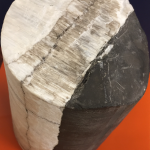 Human Resources Training. The initiative is aimed at developing strategies to optimize the Mexican production portfolio. The workshop was held April 11th-13th in Mexico City.
Human Resources Training. The initiative is aimed at developing strategies to optimize the Mexican production portfolio. The workshop was held April 11th-13th in Mexico City.
Machine Learning | On March 30, S.E. Laubach kicked off the DOE BES workshop Disentangling Signals from Evolving Fracture Systems: The Machine Learning/Deep Learning Challenge with a review of fracture systems. More news from the workshop will be forthcoming. Read AGU abstract 2018
Celebrating 20+ years of tech transfer innovation | The BEG web site features a news item about our fracture research web site launched more than twenty years ago. See how Frac City came about.
Publication Impact | According to the publisher, in March the following initiative articles remain on the list of top-twenty most downloaded articles from the Journal of Structural Geology in the last 90 days:
- Microfractures: a review | #1 | view
- Correlation analysis of fracture arrangement in space | #14 | view
- Spatial arrangement of faults and opening-mode fractures | #16 | view
Of the most cited articles published since 2012, the following initiative articles are in the top 20.
- Microfractures: a review | #6 | view
- Fracture-aperture size-frequency, spatial distribution, and growth processes in strata-bounded and non-strata-bounded fractures, Cambrian Meson Group, NW Argentina | #8 | view
Fluid Inclusion Conference 2018 | Andras Fall is on the organizing committee for PACROFI XIV, the premier Pan-American international conference for fluid inclusion research. The conference will be held at Rice University in Houston from June 11-16. Fall will also deliver the opening presentation in a one-day short course on fluid inclusions in petroleum systems. Contact Andras Fall for more information. Or see the conference web page.
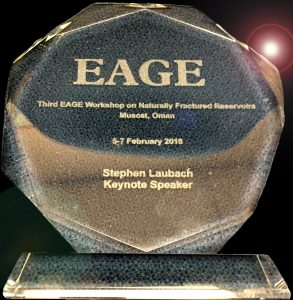 Invited talk | S. E. Laubach: Fracture system attributes relevant to geophysics. Basic Energy Sciences workshop, Information is in the Noise: Signatures of Evolving Fracture Systems. March 28-30, 2018, Gaithersburg, MD
Invited talk | S. E. Laubach: Fracture system attributes relevant to geophysics. Basic Energy Sciences workshop, Information is in the Noise: Signatures of Evolving Fracture Systems. March 28-30, 2018, Gaithersburg, MD
Keynote | S. E. Laubach: Structural diagenesis of fracture systems. Tuesday 6 February, 2018, 2 p.m. Third EAGE Workshop on Naturally Fractured Reservoirs: Muscat, Oman
2017 Highlights
Connecting SDI science with Society | An overview of SDI science and goals written for the general public was recently published in Scientia. | For PodCast | For the web version | For a printable version | For twitter | For Facebook
SDI at GSA Annual Meeting | SDI research is featured in 15 presentations, including invited and keynote talks, at the GSA annual convention in Seattle. For more information see Events.
Vaca Muerta focused papers | The Vaca Muerta Formation, located in the Neuquén Basin in Argentina, is the host rock for major deposits of tight oil (shale oil) and shale gas. Two new project papers explore the structural diagenesis of these important rocks.
- New type of kinematic indicator in bed-parallel veins, Late Jurassic–Early Cretaceous Vaca Muerta Formation, Argentina: E-W shortening during Late Cretaceous vein opening. Ukar, E., Lopez, R.G., Gale, J.F.W., Laubach, S.E., Manceda, R., 2017. Journal of Structural Geology doi:10.1016/j.jsg.2017.09.014 | view
- Microfractures in bed-parallel veins (beef) as predictors of vertical macrofractures in shale: Vaca Muerta Formation, Agrio Fold-and-Thrust Belt, Argentina. Ukar, E., Lopez, R.G., Laubach, S.E., Gale, J.F.W., Manceda, R., and Marrett, R., 2017. South American Journal of Earth Sciences 79, 152-169. doi.org/10.1016/j.jsames.2017.07.015 | view
Impact | Project papers published in the Journal of Structural Geology continue to have impact. According to the publisher’s website, as of November 2017, two project papers are among the most cited articles published since 2012:
- Microfractures: A review | read the paper
- Fracture-aperture size-frequency, spatial distribution, and growth processes in strata-bounded and non-strata-bounded fractures, Cambrian Mesón group, NW Argentina | read the paper
Four papers are recognized as being among the most downloaded in the past 90 days (top 25):
- Microfractures: A review (#1) | read the paper
- Correlation analysis of fracture arrangement in space (#9) | read the paper
- Quantifying opening-mode fracture spatial organization in horizontal wellbore image logs, core and outcrop: Application to Upper Cretaceous Frontier Formation tight gas sandstones, USA (#15) | read the paper
- Spatial arrangement of faults and opening-mode fractures (#22) | read the paper
Spatial arrangement | Papers from the Special Issue on spatial arrangement are now [July-August] being posted on the Journal of Structural Geology website. Spatial arrangement is a fundamental characteristic of fault and opening-mode fracture arrays, important for many reasons including defining structural heterogeneity and anisotropy and governing of how faults and fractures affect fluid flow. Increasingly, quantification of spatial arrangement is central to understanding origins of fault and opening-mode fracture patterns. Edited by S. E. Laubach, Juliette Lamarche, Bertrand Gauthier, and William M. Dunne, this special issue highlights recent progress and examples of fault and fracture patterns over a wide range of scales and structural settings. Five project papers are highlighted:
- Spatial arrangement of faults and opening-mode fractures. Laubach, S.E., Lamarche, J., Gauthier, B.D.M., Dunne, W.M., and Sanderson, D.J., 2017, Journal of Structural Geology. doi:org.10.1016/j.jsg.2017.08.008 | view
- Correlation analysis of fracture arrangement in space. Marrett, R., Gale, J.F.W., Gomez, L., and Laubach, S.E., 2017. Journal of Structural Geology. doi.org/10.1016/j.jsg.2017.06.012 | view
- Microfracture spacing distributions and the evolution of fracture patterns in sandstones. Hooker, J.N., Laubach, S.E., and Marrett, R., 2017. Journal of Structural Geology. doi.org/10.1016/j.jsg.2017.04.001 | view
- Quantifying opening-mode fracture spatial organization in horizontal wellbore image logs, core and outcrop: application to Upper Cretaceous Frontier Formation tight gas sandstones, USA. Li, J.Z., Laubach, S.E., Gale, J.F.W., and Marrett, R., 2017. Journal of Structural Geology. doi.org/10.1016/j.jsg.2017.07.005 | view
- Spatial arrangement and size distribution of normal faults, Buckskin Detachment upper plate, Western Arizona. Laubach, S.E., Hundley, T.H., Hooker, J.N., Marrett, R., 2017. Journal of Structural Geology, doi.org/10.1016/j.jsg.2017.10.001 | view
2006 Classics in Oil, Petroleum & Natural Gas | According to Google Scholar citations, a project paper by Ortega, Marrett and Laubach is among the top cited in this field for that year. Classic papers are highly-cited papers in their area of research that have stood the test of time. For each area, Google Scholar lists the ten most-cited articles that were published ten years earlier.
This release of classic papers consists of articles that were published in 2006 and is based on the Scholar index as it was in May 2017. The list of classic papers includes articles that presented new research, to the extent the Scholar indexing system is able to automatically determine. The list specifically excludes review articles, introductory articles, editorials, guidelines, and commentaries. Ortega et al. was also previously recognized as an AAPG Notable Paper by the AAPG Bulletin editorial board.
- Ortega, O. J., Marrett, R., and Laubach, S. E., 2006, A scale-independent approach to fracture intensity and average fracture spacing: AAPG Bulletin, v. 90, no. 2 (Feb. 2006), 193-208. | View the paper
Texas Ten | Long-time SDI collaborator Maša Prodanović has been named to the Texas Ten, professors recognized by alumni as having had a lasting impact on their lives. Read the Alcalde article
Awards | EER MSc. student Abdulaziz Almansour is the recipient of the 2017 Director’s Award from the Energy and Earth Resources Graduate Program in recognition of his insightful research and an outstanding presentation of the work at the recent Jackson School Master’s Saturday Symposium. The recognition is accompanied by a substantial cash prize, which Abdulaziz shares with fellow EER student and co-awardee Ben Griffiths. Abdulaziz was also a finalist among all Jackson School students for an award for the best-written abstract.
Abdulaziz’ research, Multidisciplinary technology and economic impact study of fracture prediction methods, applies geologic, engineering, and economic analysis approaches to evaluate the technical effectiveness and economic value of a fracture characterization method that uses limited subsurface information to diagnose the presence or absence of open fractures. Software Abdulaziz developed as part of the study allows decision makers to calculate the value of information using play-specific geologic and cost parameters to evaluate any type of technology or test. One outcome of the research on the fracture diagnostic method is a tangible demonstration of the high economic value of new, fundamental insights into natural fracture processes developed in the SDI program. A manuscript describing Abdulaziz’ study will be available before the end of the summer.
 S.E. Laubach and Eric Bickle are Abdulaziz’ research supervisors. Bickle, professor of Operations Research and Industrial Engineering at UT, has published extensively on decision analysis.
S.E. Laubach and Eric Bickle are Abdulaziz’ research supervisors. Bickle, professor of Operations Research and Industrial Engineering at UT, has published extensively on decision analysis.
About EER | The Energy and Earth Resources Graduate Program provides the opportunity for students to pursue interdisciplinary studies in areas of geosciences, engineering, management, finance, economics, law and policy. Private sector and government organizations face a growing need for professionals that can plan, evaluate, and manage complex resource projects, commonly international in scope, which commonly include partners with interdisciplinary professional backgrounds. This program is well suited for those looking towards 21st century careers in energy, mineral, water, and environmental resources and many students move to leadership positions in industry and government.
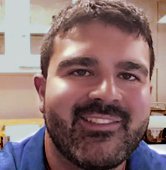 Awards | Ph.D. student Matt Ramos was the first place award winner of the 5th Ben Caudle Simple Energy Concepts Prize from the Department of Petroleum & Geosystems Engineering. Matt’s topic was ‘Electrical resistivity visualization for identifying subsurface fluids.’ Matt will present lectures on his award-winning concept at “Introduce a girl to engineering day” and “Explore UT” on Feb. 25 and Mar. 4, respectively. Matt’s dissertation in the Jackson School is supervised by Nicholas Espinoza and Steve Laubach and concerns laboratory quantification of fracturing through combined ultrasonic and triaxial testing and applications to interpretation of geophysical signals over a range of scales. Matt’s research is supported by a Statoil Fellowship. Read more about Ramos and the award.
Awards | Ph.D. student Matt Ramos was the first place award winner of the 5th Ben Caudle Simple Energy Concepts Prize from the Department of Petroleum & Geosystems Engineering. Matt’s topic was ‘Electrical resistivity visualization for identifying subsurface fluids.’ Matt will present lectures on his award-winning concept at “Introduce a girl to engineering day” and “Explore UT” on Feb. 25 and Mar. 4, respectively. Matt’s dissertation in the Jackson School is supervised by Nicholas Espinoza and Steve Laubach and concerns laboratory quantification of fracturing through combined ultrasonic and triaxial testing and applications to interpretation of geophysical signals over a range of scales. Matt’s research is supported by a Statoil Fellowship. Read more about Ramos and the award.
Highly Cited Recognition | According to the publisher, a project paper by Hooker, Laubach and Marrett is among the top 20 most cited papers since 2012 in the Journal of Structural Geology.
Hooker, J.N., Laubach, S.E., and Marrett, R., 2013, Fracture-aperture size–frequency, spatial distribution, and growth processes in strata-bounded and non-strata-bounded fractures, Cambrian Mesón Group, NW Argentina. Journal of Structural Geology, v. 54, p. 54-71. doi.org/10.1016/j.jsg.2013.06.011, | view at publisher
Based on a comprehensive study of fractures in Cambrian rocks in Argentina, the paper demonstrated that power-law opening-displacement size distributions may be favored in cases where fracture growth is unequally partitioned amongst variably cemented fractures, whereas a characteristic size is favored where growth is unaffected by cementation. Other key fracture attributes such as fracture height also vary with diagenetic pathway at the time of fracturing. Results imply that thermal history and diagenesis are important for fracture-size-distribution patterning.
The paper also introduced the first classification of fracture height patterns. The classification has become widely accepted and used.
In addition to being recognized as a 2017 Top 25 most-cited paper in the past 5 years, the paper was recognized with the Jackson School Publication Bronze Award for student-authored publication and Best Student Paper Award in Jackson School of Geoscience Energy Theme, and has been noted for high download activity by the publisher.
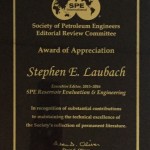 SPE Service | Steve Laubach received an Award of Appreciation from the Society of Petroleum Engineers for his recently concluded service as Executive Editor for the journal SPE Reservoir Evaluation & Engineering.
SPE Service | Steve Laubach received an Award of Appreciation from the Society of Petroleum Engineers for his recently concluded service as Executive Editor for the journal SPE Reservoir Evaluation & Engineering.
2016 Highlights
Structural diagenesis lecture at University of Oxford | S. E. Laubach presented “Reconstructing fracture opening histories and timing using structural diagenesis” at Oxford on Friday, 2 December.
During the past decade the need for accurate predictions of the attributes of fractures and faults at depth in the Earth has become urgent. Uncertainty about the fundamental properties of these features threatens the reliability of engineering operations such as fluids injected underground and the efficiency and success of engineering operations in, for example, unconventional and deep hydrocarbon resources, and geothermal systems.
Recent studies show that most near-surface fracture patterns differ in many important ways from fractures found in the deep subsurface. Differences include size, shape, spatial arrangement, and internal porosity structure. Deep-seated fractures contain evidence of extensive chemical reactions within the fracture systems. Evidence includes complex, albeit in many cases inconspicuous, mineral deposits and trapped fluids. Many of these reactions can be shown to have occurred during fracture array growth.
Some recent work suggests that the missing ingredient for accurate fracture predictions is the interaction of mechanical and chemical processes, including the mechanical effects of accumulation of natural chemical precipitates (cement), during fracture array growth. The presentation described recent advances in taking these processes into account, prospects for improved models, and implications for anticipating reservoir behavior.
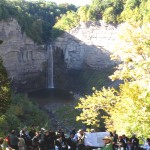
Gale, Laubach, Olson and NY shale, 2012 field trip
Highly Cited Recognition | For Gale, Laubach, Olson et al., 2014, Natural fractures in shale: a review and new observations. According to ISI Web of Science, as of May/June 2016, this highly cited paper received enough citations to place it in the top 1% of its academic field based on a highly cited threshold for the field and publication year. See the paper
Featured Researcher | András Fall is profiled on the Bureau of Economic Geology web site. Fall conducts research on fractures using fluid inclusion, Raman spectroscopy, and CL methods, and studies fluids in diagenetic and hydrothermal systems. Fall’s hydrothermal laboratory is exploring processes that help preserve and destroy fracture porosity. See the article
High Cited Recognition | Rich Schultz is co-author with Haakon Fossen and Anita Torabi of Conditions and implications for compaction band formation in the Navajo Sandstone, Utah, 33/10, 2011, Journal of Structural Geology. According to the publisher this is one of the most-cited articles in the journal since 2011. See the paper
No. 1 in downloads | The paper ‘Microfractures: A Review’ by Anders, Laubach and Scholtz, as of September 2016 remains the most-downloaded article from Journal of Structural Geology according to the publisher. See the paper
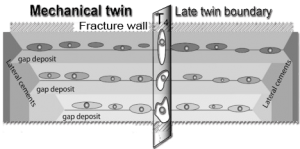 New insights into Dauphiné twins and stress history | Fall et al. 2016, recently published online in Tectonophysics, documents that under diagenetic temperatures–less than 200°C–and burial depths less than 5 km Dauphiné twins are common in isolated fracture quartz deposits spanning between fracture walls (i.e., quartz bridges) in low-porosity quartz-cemented sandstones.
New insights into Dauphiné twins and stress history | Fall et al. 2016, recently published online in Tectonophysics, documents that under diagenetic temperatures–less than 200°C–and burial depths less than 5 km Dauphiné twins are common in isolated fracture quartz deposits spanning between fracture walls (i.e., quartz bridges) in low-porosity quartz-cemented sandstones.
The association of Dauphiné twins and fluid inclusion assemblages from which temperature and timing can be inferred provides a way to research timing as well as magnitude of paleostress in some diagenetic settings.
For more information see: Fall, A., Ukar, E., Laubach, S.E., 2016, Origin and timing of Dauphiné twins in quartz cement in fractured sandstones from diagenetic environments: insight from fluid inclusions. Tectonophysics doi.org/10.1016/j.tecto.2016.08.014 | view at publisher
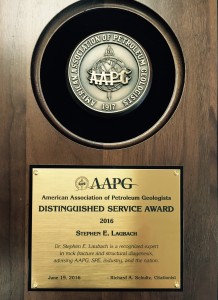 AAPG Distinguished Service Award | S. E. Laubach received an AAPG Distinguished Service Award at the AAPG Annual Convention in Calgary in June. The award citation noted research in rock fracture and structural diagenesis and service to AAPG and industry. Laubach served on the AAPG Executive Committee and was AAPG Elected Editor from July 2010–July 2013. BEG News item
AAPG Distinguished Service Award | S. E. Laubach received an AAPG Distinguished Service Award at the AAPG Annual Convention in Calgary in June. The award citation noted research in rock fracture and structural diagenesis and service to AAPG and industry. Laubach served on the AAPG Executive Committee and was AAPG Elected Editor from July 2010–July 2013. BEG News item
Recognition from the Geological Society of America | S. E. Laubach and R. A. Schultz are newly elected Fellows of the Geological Society of America, April, 2016. GSA members are elected to Fellowship in recognition of distinguished contributions in the geosciences. Laubach and Schultz will be recognized by GSA at the Annual Meeting in Denver, September 2016. From GSA | BEG News item
SPE Distinguished Member Award | Jon E. Olson has received a prestigious SPE international award. The Distinguished Member Award recognizes SPE members who achieve distinction deemed worthy of special recognition. This award acknowledges members who have attained eminence in the petroleum industry or the academic community, or who have made significant contributions to SPE. Jon will be recognized with the award at the SPE ATCE in Dubai in September.
SPE Distinguished Achievement Award | Richard Schultz has received a prestigious SPE regional award. He was recognized in May with the 2016 Completions Optimization and Technology Regional Award from SPE’s Gulf Coast North America Region for his geomechanics research. Regional and section awards recognize members who contribute exceptional service and leadership within SPE, as well as making significant professional contributions within their technical disciplines at the SPE regional level.
Service | Richard Schultz has been appointed to the Interstate Oil & Gas Compact Commission Energy Resources, Research & Technology Committee.
Service | S.E. Laubach has been appointed to the Reservoir Description and Dynamics Advisory Committee of the Society of Petroleum Engineers.
Basic Energy Sciences workshop | A successful workshop on the mechanics and chemistry of fracture pattern evolution was held on May 9 – 10 at the National Conference Center in Leesburg, VA. A report on the workshop will be forthcoming. Contact S. E. Laubach for more information.
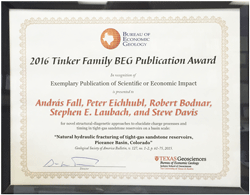
2016 Publication Award | Fall et al.
Andras Fall and co-authors Peter Eichhubl, Bob Bodnar, S. E. Laubach, and Steve Davis received the 2016 Tinker Family BEG Publication Award In recognition of Exemplary Publication of Scientific or Economic Impact for their 2015 paper “Natural hydraulic fracturing of tight-gas sandstone reservoirs, Piceance Basin, Colorado” published in the Geological Society of America Bulletin, v. 127, no. 1-2, p. 61-75.
The award citation noted that the paper used novel structural-diagenetic approaches to elucidate charge processes and timing in tight-gas sandstones on a basin scale.
The paper was selected for the award by the Bureau’s editorial board from more than 140 papers published in 2015 in the peer-reviewed international literature by Bureau scientists.
The paper was published open access and can be found at GSA’s web site or at GeoscienceWorld | view at publisher
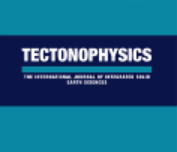
Advances in imaging textures in carbonate rocks published in Tectonophysics. Fracture-filling cements in fractured and faulted upper crustal rocks provide information on the elemental and isotopic chemistry of formation fluids, and fluid pressure and temperature. A new paper by Ukar and Laubach documents fracture cement textures in a suite of fractured carbonate rocks using a state-of-the-art SEM and CL, showing that with minimal phosphorescence, some apparently massive and featureless fracture calcite deposits contain crack-seal and cement growth textures. A key result is the discovery of calcite cement deposits that have bridge-like shapes and crack-seal texture that resembles textures in quartz in more thoroughly studied sandstone fractures, suggesting that some of the apparent differences between carbonate mineral and quartz deposits in fractures is an artifact of limitations in imaging | view at publisher
Special Issue of JSG | R. Marrett, S. E. Laubach, Bertrand Gauthier, Julliette Lamarche and Bill Dunne are organizing a Special Issue of the Journal of Structural Geology on the spatial arrangement of fractures and faults. Papers are due in December 2016. For more information contact S. E. Laubach. | Read the journal announcement
Presentations | R. Marrett and S. E. Laubach presented invited lectures in Korla, western China on May 26. Marrett, Laubach, and postdoctoral fellow Vinyet Baqués also conducted field work in the northwestern Tarim Basin.
Student Awards and Recognition | Casey O’Brien was voted best speaker for Spring 2016 MS Thesis Day. This award is a considerable honor. The Jackson School’s MS Thesis Day features presentations by all students in the program. PhD candidate Owen Callahan was recognized with a Best TA award from the Jackson School. John Li has been notified that he will receive an AAPG Grants-in-Aid award. He was selected for support from the Edward C. and Caroline Beaumont Named Grant. He will use the support to conduct petrography on fractures in Vaca Muerta cores to inform his horizontal image log analysis.
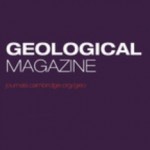
An account of the persistence of open fractures at depth published in Geological Magazine | Laubach et al. describe fractures that retained open pore space through protracted burial and uplift despite loading tending to close them. Examples are from horizontal wells in the Wyoming province foreland basin. Long-term persistence of open fractures has implications for the role of weak pre-existing fractures on structure development and fluid flow, including fluid production response in geothermal and oil and gas applications.
Geological Magazine, established in 1864, is one of the oldest and best-known periodicals in the Earth Sciences. Its worldwide circulation, broad scope and high production values keep the journal at the forefront of the field. It publishes original papers, review articles, rapid communications and discussions about all aspects of the geosciences.
- Reference: Laubach, S.E., Fall, A., Copley, L.K., Marrett, R., Wilkins, S., 2016, Fracture porosity creation and persistence in a basement-involved Laramide fold, Upper Cretaceous Frontier Formation, Green River Basin, U.S.A. Geological Magazine. doi:10.1017/S0016756816000157 | view at publisher
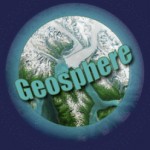 Test of Lander/Laubach model published in GEOSPHERE | Ukar et al. evaluated the Lander/Laubach model for crystal growth patterns in quartz cement in sandstone fractures by comparing crystal fracture-spanning predictions to quartz c-axis orientation distributions measured by electron backscatter diffraction (EBSD) of spanning quartz deposits.
Test of Lander/Laubach model published in GEOSPHERE | Ukar et al. evaluated the Lander/Laubach model for crystal growth patterns in quartz cement in sandstone fractures by comparing crystal fracture-spanning predictions to quartz c-axis orientation distributions measured by electron backscatter diffraction (EBSD) of spanning quartz deposits.
Results support the model, which predicts that for quartz deposited synchronously with fracture opening, spanning potential, or likelihood of quartz deposits that are thick enough to span between fracture walls, depends on temperature history, fracture opening rate, size of opening increments, and size, mineralogy, and crystallographic orientation of substrates in the fracture wall (transected grains).
The study shows that EBSD maps, which can be more rapidly acquired than other data that can test the model, can provide a useful measure of relative opening rates within populations of quartz-filled fractures formed under sedimentary basin conditions. Such data are useful for evaluating fracture pattern development models.
- Reference: Ukar, E., Laubach, S.E., and Marrett, R., 2016, Quartz c-axis orientation patterns in fracture cement as a measure of fracture opening rate and a validation tool for fracture pattern models: Geosphere, v. 12, no. 2, p. 400–438, doi: 10.1130/GES01213.1. | view at publisher
Presentations | Esti Ukar presented results of our EBSD-fracture cement studies at the Microanalysis Society‘s Electron Backscatter Diffraction 2016 conference on May 24-26th at the University of Alabama in an invited keynote lecture. Event Details.
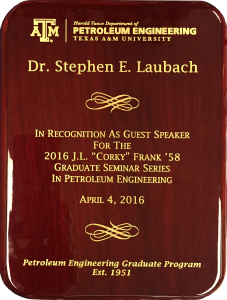 Presentations | S. E. Laubach presented an invited lecture at the Department of Petroleum Engineering, Texas A&M University on April 4. The topic of the talk was project work on structural diagenetic controls on development of fracture patterns and fracture length distributions.
Presentations | S. E. Laubach presented an invited lecture at the Department of Petroleum Engineering, Texas A&M University on April 4. The topic of the talk was project work on structural diagenetic controls on development of fracture patterns and fracture length distributions.
Service | Julia F. W. Gale is the Theme Lead for the Structure, Tectonics, and Geomechanics Theme for the 2017 AAPG Annual Convention and Exhibits (ACE) in Houston. Julia is currently–March 2016–soliciting proposals for oral and poster sessions for the meeting.
Service | S. E. Laubach is serving as Executive Editor for the journal SPE Reservoir Evaluation & Engineering through Fall 2016. SPE REE covers a wide range of topics, including reservoir characterization, geology and geophysics, core analysis, well logging, well testing, reservoir management, EOR, fluid mechanics, performance prediction, and reservoir simulation. Published quarterly by the Society of Petroleum Engineers in February, May, August, and November. See the current issue.
Service | S. E. Laubach is a member of the Scientific Committee for the 21st International Conference on Deformation Mechanisms, Rheology and Tectonics (DRT) to be held May 3-6 2017 in Ullapool, Scotland. Paper submissions will be due Tuesday, 17 January 2017.
Hot | Natural hydraulic fracturing of tight-gas sandstone reservoirs, Piceance Basin, Colorado is Number 1 for February 2016 on the “Most Read” list for GSA Bulletin on GeoscienceWorld. Reference: Fall, A., Eichhubl, P., Bodnar, R. J., Laubach, S. E., Davis, J. S., 2015, Natural hydraulic fracturing of tight-gas sandstone reservoirs, Piceance Basin, Colorado. Geological Society of America Bulletin. v. 127, no. 1-2, p. 61-75. doi:10.1130/B31021.1 | view at publisher
Still hot | Microfractures: A Review is still Number 1 on the “Most Downloaded Articles” list for the Journal of Structural Geology. The list, accessed 17 March, 2016, is based on downloads in the previous 90 days. The paper has been at or near the top of the list since it was published in 2014. Authors: M.H. Anders, S.E. Laubach & C.H. Scholz. Go to the article (JSG v. 69, Part B, 377-394).
2015 Highlights
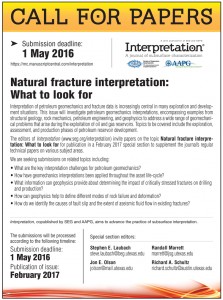 Natural Fractures: What to Look For | May 2016
Natural Fractures: What to Look For | May 2016
Interpretation of fracture and geomechanics data is increasingly central to understanding the subsurface. Fractures can have a profound impact on many types of subsurface engineering procedure.
To help advance our understanding of fractures and how fracture interpretation, including uncertainties, influences practical applications, Steve Laubach, Rich Schultz, Jon Olson and Randy Marrett are organizing a special issue of the SEG and AAPG journal Interpretation on the topic of natural fracture interpretation: what to look for.
Papers are sought covering all aspects of fracture and fault interpretation.
Specifically, the volume will address the following questions. What are the interpretation challenges? How have geomechanics interpretations been applied throughout asset life cycles? What information can geophysics provide? And can we identify the causes of fault slip and the extent of aseismic fluid flow?
Papers are due 1 May 2016. The issue will be published in February 2017. For more information or to submit a paper, see the Interpretation site.
 Distinguished Service Award | Laubach
Distinguished Service Award | Laubach
The American Association of Petroleum Geologists recently announced that S. E. Laubach will receive a Distinguished Service Award in June 2016 at the annual convention in Calgary.
Laubach served on the AAPG Executive Committee and was AAPG Elected Editor from July 2010–July 2013. During that time he helped found the new structure and geomechanics technical division, was involved in helping launch the new joint AAPG-SEG journal, Interpretation, founded the AAPG Chas. H. Taylor Fellowship in support of scientific publishing in 2012, restructured the AAPG Bulletin‘s editorial board, founded the AAPG Books Editorial Board, and instituted AAPG Bulletin‘s online Ahead of Print publishing and Notable Papers recognition.
Presentation Award | Gale
Julia F.W. Gale and co-authors were recently recognized with a certificate from AAPG for a “Top 10 Poster Presentation” at 2015 AAPG ACE meeting in Denver. The poster on “Bedding-Parallel Fractures in Shales: Characterization, Prediction and Importance” by Gale, E. Ukar, Q. Wang and S. Elliott is part of our investigation of the structural diagenesis of shale fracture systems. Bed-parallel fractures in shale are the focus of Qiqi Wang’s M.S. thesis.
Spacing and Synkinematic Cement
John N. Hooker (PhD 2012) and former Structural Diagenesis Initiative researcher now at Oxford University recently made a new and interesting contribution in a paper in American Journal of Science. Vein spacing in extending, layered rock: The effect of synkinematic cementation by Hooker and R.F. Katz uses modeling to explore the consequences for fracture spacing of the interaction of fracture growth and cementation. American Journal of Science 315 (6), 557-588.
GeoscienceWorld ‘Most-Read Articles’ October 2015
Project papers published in Geological Society of America Bulletin continue to attract attention, as measured by down loads, according to the publisher. These papers were in the top 50 list.
Project papers still in JSG ‘Hottest Articles’ list April – June 2015
According to the publisher two project papers are in the top 25 Journal of Structural Geology most accessed via downloads list for April to June, 2015.
- 7. Microfractures: A review
Journal of Structural Geology, 2014, Volume 69, Pages 377-394
Anders, M.H.; Laubach, S.E.; Scholz, C.H. - 18. Non-linear growth kinematics of opening-mode fractures
Journal of Structural Geology, 2015, Volume 74, Pages 31-44
Alzayer, Y.; Eichhubl, P.; Laubach, S.E.
2015 Award | AAPG Bulletin Notable papers for 2012
A project paper has been recognized as one of ten Notable Papers for 2012 by the AAPG Bulletin Editorial Board. The Notable Papers list is based in part on a review of citation counts three years after publication of the paper and on editorial board review. For other AAPG Notable Papers based on our project research, see the Publications page.
- Fall, A., Eichhubl, P., Cumella, S.P., Bodnar, R.J., Laubach, S.E., & Becker, S.P., 2012, Testing the basin-centered gas accumulation model using fluid inclusion observations: southern Piceance Basin, Colorado. AAPG Bulletin, v. 96, no. 12, p. 2297-2318. doi:10.1306/05171211149 | view at GSW
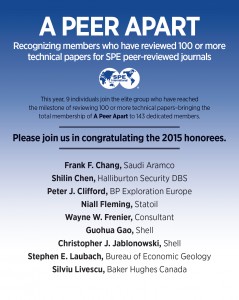
Reviewing Recognition 2015
Recognition for Reviewing 2015
S. E. Laubach was recently selected by the SPE Reservoir Evaluation & Engineering Executive Editors and Associate Editors to receive an award for “Outstanding Service” in 2015. According to the Society of Petroleum Engineers, this award is an international recognition for excellence as a Technical Editor of SPE’s peer-reviewed scholarly journals. According to SPE only 0.1% of SPE’s 110,000 members worldwide ever receive this award.
For more information see SPE Reservoir Evaluation & Engineering.
SPE previously recognized Laubach with an Award of Appreciation as an Outstanding Technical Editor in 2009 and 1999.
SPE also recognized Laubach in September for having reviewed 100 or more technical papers for the Society of Petroleum Engineers. The ‘Peer Apart’ group has 143 members.
Laubach serves as an Associate Editor for SPE Reservoir Evaluation & Engineering, as well as serving on the editorial boards of SEG’s journal Interpretation and the Journal of Structural Geology. Laubach was AAPG Elected Editor from 2010-2013 and previously served two terms on the AAPG Bulletin editorial board.
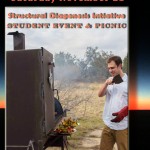
Student Event & Picnic
Structural Diagenesis Initiative Student Event & Picnic
The annual SDI student event and picnic is scheduled for Saturday, November 21. Contact Steve Laubach for more information. All friends of structure and diagenesis are welcome to attend.
New Students in the Structural Diagenesis Initiative
Seven students in the Department of Petroleum & Geosystems Engineering and twelve students in the Department of Geological Sciences are conducting dissertation or MS thesis research within the Structural Diagenesis Initiative in Fall 2015.
New and continuing students will be introduced to the initiative industry review panel during the annual research review meeting on September 24th and 25th, and many of the students will present results of their ongoing work.
Lecture in Marseille, France
S. E. Laubach delivered an invited lecture on initiative research on October 1st at Aix-Marseille University.
Olson summarizes program research for CPGE Board
On September 9th, Jon Olson summarized initiative research for the Center for Petroleum & Geosystems Engineering board of directors.
Lecture at University of Wisconsin-Madison
Peter Eichhubl presented an invited lecture on initiative research at the University of Wisconsin in Madison on September 11th.
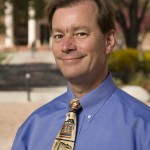
Richard Schultz
Rich Schultz joins SDI & FRAC
Dr. Richard A. Schultz has been appointed Senior Research Scientist with the Center for Petroleum and Geosystems Engineering at The University of Texas at Austin. Working with Jon Olson in Petroleum & Geosystems Engineering (PGE), Rich will conduct integrated structural geology and geomechanics research, work with students in PGE and JSG, and strengthen cross-disciplinary geomechanics collaboration across the Structural Diagenesis Initiative.
Rich brings a record of creative research, benchmark publication, and thoughtful mentoring.
Prior to joining PGE, he was Principal Geomechanicist with ConocoPhillips where he focused on the characterization and geomechanics of reservoir and overburden sequences with wide applications.
Prior to working at ConocoPhillips Dr. Schultz served on the faculty of the University of Nevada, Reno (UNR), culminating as Foundation Professor of Geological Engineering and Geomechanics, Emeritus. He taught a wide range of undergraduate and graduate courses in structural geology, geological engineering, fracture mechanics, geomechanics, physical and environmental geology, and planetary science. His grant-funded Geomechanics-Rock Fracture Group produced 5 Ph.D. and 13 M.S. students, 2 postdoctoral scholars, and an international reputation for innovative research and excellent presentations. Schultz has served on the Editorial Board of Lithosphere, Journal of Structural Geology, and Journal of Geophysical Research.
With a broad background and deep insights into mechanics, Rich will play a key role in the Structural Diagenesis Initiative. He will be involved in efforts to develop an integrated structural-mechanical-diagenetic fracture model, rock property testing, and fault studies among other duties.
More information about Rich’s research interests and publications is posted under Geomechanics and Rock Fracture.
Master Class | Fall 2015 Schedule
Times and dates for the Fall Structural Diagenesis master class have been set. See the class page for more information.
Keynotes | J.F.W. Gale
Progress on using structural diagenetic and other quantitative approaches to understand fractures in shales—and an informative lecture style—has made Julia F.W. Gale a sought-after speaker. In addition to her 2013-2014 AAPG Distinguished Lecture tour and numerous presentations to industry groups, this year Gale presents three invited keynote talks in the UK. For more information see Events
Structural Diagenesis Blog Launches
See the new Structural Diagenesis blog. We will initially use the new site capability to highlight recent published results but we have more ambitious plans for the future.
Impact papers | Retrospective on 2010
In retrospect 2010 was a strong year for SDI research publications. Three project papers have been recognized as among the top 25 most highly cited papers since 2010 by the publisher of Journal of Structural Geology.
- Pure and shear-enhanced compaction bands in Aztec Sandstone Eichhubl, Hooker, Laubach | 2010
- Structural diagenesis Laubach, Eichhubl, Hilgers, Lander | 2010
- Modeling fracture porosity evolution in dolostone Gale, Lander, Reed, Laubach | 2010
Gale et al. 2010 Modeling Fracture Porosity Evolution in Dolostone also won the Bureau of Economic Geology Publication Award in 2011.
Two 2010 papers by Twiss and Marrett in Journal of Structural Geology, Determining brittle extension and shear strain using fault length and displacement systematics, Part I Theory and Part II Data evaluation and test of the theory, set a new benchmark in quantitative fault studies.
Becker et al. 2010 A 48 m.y. history of fracture opening, temperature, and fluid pressure: Cretaceous Travis Peak Formation, East Texas basin remains the 3rd most cited recent article in Geological Society of America Bulletin, according to the publisher. See Publications for links to these papers.
Project Review Meeting Set for September 24-25
Meeting in Fall 2015 will be held in Austin at the UT Research Campus. Contact Julia Gale or Steve Laubach for more information.
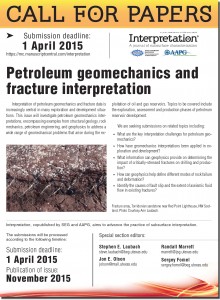 Distinguished Lecture Tour | Lander
Distinguished Lecture Tour | Lander
Rob Lander is the 2015 Haas-Pratt Distinguished Lecturer for AAPG. He will present Model the Rock! Using Diagenesis Simulation for Rock Property Prediction on his North American lecture tour in early 2015. Lander will lecture in Austin on February 23rd.
Interpretation issue on Geomechanics and Fractures
Laubach, Marrett, Olson and Fomel are editing a Special Section on petroleum geomechanics and fracture interpretation for the SEG-AAPG journal INTERPRETATION. Papers are due on April 1 2015, and the publication date is November 2015.
More Special Section editors are sought. For more information, contact Steve Laubach or see the Interpretation special section page.
New SEM CL Facility Setting New Standards
Our new, automated, high-resolution SEM CL instruments are revealing striking new complexity and textural detail within fractured and faulted rocks. Read about the instruments here. Manuscripts incorporating new image results are in preparation.
2014 Highlights
Overview of 2014 | Initiative-Specific Topics
The capacity of a structural diagenetic approach to unravel previously indistinguishable fracture causes was demonstrated in several integrated studies in 2014. A Colorado example shows fractures formed in response to gas generation in adjacent shales and coals under high pore fluid pressure (Fall et al. 2015); a Mexico example shows fractures opened primarily under tectonic extension (Hooker et al. accepted). Two studies using outcrop and core data, kinematic and dynamic structural models and fracture growth reconstructions show complex fracture growth (Ukar et al., submitted, a, b).
A two-stage non-linear growth history was demonstrated in a Texas example using textural reconstruction and fluid inclusion microthermometry (Alzayer et al. submitted).
We described how rock type and diagenesis governs near-fault fracture size, openness and fault strength (Laubach et al., 2014).
We published our model that accounts for crystal growth patterns and internal textures in quartz cement in fractures, including massive sealing deposits and veneers on open fracture surfaces and bridge structures that span otherwise open fractures (Lander & Laubach, in press). A new code predicts extent of fracture bridging by quartz cement, accounting for euhedral/non euhedral nucleation surfaces, crystal size, temperature, and fracture opening and allows efficient accounting for these effects in our geomechanical model.
The figure shows output from the Lander/Laubach model: a fractured quartz grain (grey) and rapidly accumulated non-euhedral quartz (red) and slowly accumulated euhedral quartz (blue/green) record the history of fracture opening like tree rings, permitting hitherto impossible reconstructions of the histories of fracture development.
A new technique to quantify fracture spacing (Marrett et al. in preparation) applied to fracture arrays where we are testing a model that predicts size scaling based on fracture cohesion explores how fracture spatial arrangement and cementation may be related.
Diagenetic modeling and laboratory experiments show how fractures, cement textures, and mechanical properties evolve with progressive diagenesis. Experimental fracture diagenesis in the laboratory created artificial cement using a wide range of pore fluids and host minerals to test elements of fracture growth and diagenesis models.
In the context of project findings on structural diagenesis we published reviews of fracture size-scaling in sandstone (Hooker et al. 2014), microfractures (Anders, Laubach & Scholz 2014) and fractures in shale (Gale et al. 2014).
How long does it take to make a natural fracture?
The process of fracture formation by a natural increase in pore-fluid pressure has previously been referred to as natural hydraulic fracturing. Researchers work to understand these fractures through examination of fluid inclusions trapped in minerals within the fractures. In this study, Fall and colleagues conclude that natural hydraulic fractures formed over time spans of 33 to 35 million years, driven by the slow generation of natural gas. The article was a GSA Bulletin ‘Featured Article‘ in July 2014.
Fall, A., Eichhubl, P., Bodnar, R. J., Laubach, S. E., Davis, J. S., 2015, Natural hydraulic fracturing of tight-gas sandstone reservoirs, Piceance Basin, Colorado. Geological Society of America Bulletin. v. 127, no. 1-2, p. 61-75. doi:10.1130/B31021.1 | view at publisher
- GSA Bulletin ‘Featured Article‘. No. 2 ‘Most read’ January 2015; No. 9 November 2014, No. 23 October 2014; No. 22 February 2016 according to publisher.
Jon Olson Named Chair of UT Petroleum & Geosystems Engineering
Dr. Jon Olson, who currently holds the George H. Fancher Professorship in Petroleum Engineering and has spent 20 years as a faculty member at The University of Texas at Austin, has been appointed chair of the Department of Petroleum and Geosystems Engineering (PGE) in the Cockrell School of Engineering.
On Jan. 1, he will take the helm of a department that is considered one of the most prestigious petroleum engineering programs in the world, with 22 faculty members and more than 730 students. The department’s petroleum engineering graduate and undergraduate programs are ranked No. 1 and No. 2 respectively, according to the most recent U.S. News & World Report national rankings, and entry-level salaries for its graduates are the highest among any engineering major.
PGE faculty members and their collaborators are world leaders in petroleum-related research.
Jon is a co-founder of the Structural Diagenesis Initiative and of FRAC. Congratulations Jon!
Read more on this story on the PGE web site.
Major Review Published on Fractures in Shale | AAPG Bulletin
Our recent lead paper in a special issue of AAPG Bulletin on faulting and fracturing in shales and self-sourced reservoirs features a new compilation of observations on shale fracture systems worldwide and a critical review of previous work on natural fracture systems in shale.
Gale et al. 2014 shows that fracture systems in shales are heterogeneous. They can enhance or detract from producibility and augment or reduce both rock strength and the propensity to interact with hydraulic-fracture stimulation. Structural diagenesis provides insights that are leading to more accurate predictions of fracture attributes in these important rocks.
Gale, J. F. W., Laubach, S. E., Olson, J. E., Eichhubl, P., and Fall, A., 2014, Natural fractures in shale: a review and new observations. AAPG Bulletin, v. 98, no. 11, p. 2165-2216. doi: 10.1306/08121413151 (published November 2014) | view at GSW
Fracture Diagenesis Paper Published | GSA Bulletin
Our paper describing a new model that accounts for crystal growth patterns and internal textures in quartz cement in fractures, including massive sealing deposits, thin rinds (or veneers) on open fracture surfaces and bridge structures that span otherwise open fractures is now published in the GSA Bulletin.
Lander R.H., and Laubach, S.E., 2015, Insights into rates of fracture growth and sealing from a model for quartz cementation in fractured sandstones. Geological Society of America Bulletin, v. 127, no. 3-4, p. 516-538. doi: 10.1130/B31092.1, published online October 2014. The paper–published open access–can be viewed at the GSA Bulletin.
Petroleum Geomechanics and Fracture Interpretation Issue
Laubach, Marrett, Olson and Fomel are editing a Special Section on petroleum geomechanics and fracture interpretation for the SEG-AAPG journal INTERPRETATION. Papers will be due on April 1 2015, and the publication date is November 2015. If you are interested in joining the editorial team, contact Steve Laubach.
Interpretation of petroleum geomechanics and fracture data is increasingly central in many exploration and development situations. This issue will investigate petroleum geomechanics interpretations, encompassing examples from structural geology, rock mechanics, petroleum engineering, and geophysics to address a wide range of geomechanical problems that arise during the exploitation of oil and gas reservoirs. Topics to be covered include the exploration, assessment and production phases of petroleum reservoir development.
Impact Papers | Citations
According to GeoscienceWorld the list of 20 ‘most cited’ articles in AAPG Bulletin as of December 1, 2014 included the following Structural Diagenesis initiative papers.
#3 Practical approaches to identifying sealed and open fractures Laubach, S. E., 2003, AAPG Bulletin, v. 87, No. 4, 561-579. | view at publisher
#4 Toward more accurate quartz cement models—The importance of euhedral vs. non-euhedral growth rates Lander, R.H., Larese, R.E. & Bonnell, L.M., 2008, AAPG Bulletin, v 92, no. 11, p. 1537-1564. | AAPG Notable Paper
#8 Mechanical and fracture stratigraphy Laubach, S. E., Olson, J. E, & Gross, M. R., 2009, AAPG Bulletin, v. 93, no. 11, p. 1413-1426. | view at GSW | AAPG Notable Paper
#18 A scale-independent approach to fracture intensity and average fracture spacing Ortega, O. J., Marrett, R., & Laubach, S. E., 2006, AAPG Bulletin, v. 90, no. 2 (Feb. 2006), 193-208 .| AAPG Notable Paper | view at publisher
#20 Natural fracture characterization in tight gas sandstones: Integrating mechanics and diagenesis Olson, J. E, Laubach, S. E., & Lander, R. H., 2009, AAPG Bulletin, v. 93, no. 11, p. 1535-1549. | AAPG Notable Paper | view at publisher
GSA Symposium 2015–Brittle Structure of Rocky Mountain Reservoirs & Analogs
S.E. Laubach is organizing a Symposium for the Rocky Mountain GSA Section Meeting in Casper, Wyoming, May 21-23, 2015. The topic is Brittle Structures of Rocky Mountain Reservoirs and Reservoir Analogs.
The symposium Brittle Structures of Rocky Mountain Reservoirs and Reservoir Analogs will cover a wide range of issues including mechanical and fracture stratigraphy, fault and fracture origins and timing, fracture size and porosity patterns, and natural fracture-hydraulic fracture interaction.
Laubach appointed to Journal of Structural Geology Editorial Board
Steve Laubach has been appointed to the Editorial Board of the Journal of Structural Geology. This journal is the leading venue for publication of structural geologic research.
The Structural Diagenesis Initiative currently has two papers in press in the journal, one of which–a review of microfractures–is the #1 most downloaded paper for this journal for the past several months.
In 2010 the journal published our review of the need for structural diagenesis research (Laubach, S.E, P. Eichhubl, C. Hilgers, R.H. Lander, 2010, Structural diagenesis. Journal of Structural Geology, v. 32, no. 12, p. 1866-1872. doi:10.1016/j.jsg.2010.10.001). The publisher recognized this paper as among the top 20 cited papers in the journal since 2009. Two other SDI papers are on this list.
SDI researchers have published many papers in the journal. A notable contribution is by SDI scientist Randy Marrett. His paper with Rick Almendinger on kinematic analysis of fault-slip data is the 18th most-highly cited paper in the history of the journal.
2014 Structural Diagenesis Field Symposium
This field seminar investigated field examples of coupled brittle deformation and chemical alteration at Valley of Fire (NV), San Rafael Swell (UT), and Moab (UT) in October 2014.
The field team included Peter Eichhubl (instructor and leader), Jon Major (co-leader), Sara Elliott (co-leader), Andras Fall, Chris Landry, Zhiqiang Fan, and students Nike Tokan-Laval, Casey O’Brien, Erick Wright, Mint Doungkaew, and Peter Laciano.
For more information on the 2014 Field Symposium or on ongoing research on coupled brittle deformation and chemical alteration, contact Peter Eichhubl.
Hydrofracturing–modern & novel methods
The special section of SEG’s journal The Leading Edge edited by Jon Olson and Steve Laubach appeared in the October 2014 issue. The special section topic is modern and novel methods in hydraulic fracturing.
The rate of success in many unconventional plays for oil and gas depend strongly on finding the sweet spots, particularly with regard to TOC and maturation. However, just as important is determining where the wellbore and the hydraulic fractures are placed during drilling and completions. The articles of this special session treat the topic of detecting (or diagnosing) wellbore and fracture placement, using novel hydraulic fracture characterization techniques related to passive or active monitoring during completions or reservoir performance diagnostics once the well is put on production.
Investigation of the interaction of natural and hydraulic fractures is an ongoing part of the SDI program.
Shell Outstanding Researcher Award 2014
Congratulations to Nike Tokan-Lawal, M.S. student in the FRAC and SDI program, who will be distinguished with the Shell Outstanding Researcher Award, in recognition of her work on the SUTUR project. Nike’s work crosses the disciplinary boundary between geoscience and engineering. She recently presented some aspects of her thesis work at the URTEC meeting.
Tokan-Lawal et al., 2014, Understanding tortuosity and permeability variations in naturally fractured reservoirs: Niobrara Formation. Unconventional Resources Technology Conference, SPE-2014-1922870-MS. doi.org/10.15530/urtec-2014-1922870
16th Annual Fracture Research & Application Consortium Meeting
Scheduled for Camp Balcones Springs in the the Texas Hill Country September 15th through 17th, the meeting will feature a field workshop on new approaches to spatial organization and an introduction to new software for quantifying fracture clustering. Many SDI students will present their work to a select industry audience of structure and exploration & development experts. See the Events page for more information.
2014 Field Expedition to the Northern Tetons, Wyoming
A successful field expedition to NW Wyoming was concluded in late August. Lauren Copley’s field party examined fractures in Cambrian rocks as part of a National Park Service sanctioned research project. The study is aimed at understanding deformation patterns associated with basement-involved reverse faults. Lauren Copley will present preliminary results of the study at this year’s Geological Society of America meeting in Vancouver. The image, by Eva Laubach, field assistant and expedition photographer, shows the field party preparing to set out, at 5 am under starlight and moonlight, on a 16 mile hike covering more than 5000 ft of elevation gain to view exposures deep in the range. More information and photographs will be provided on the SDI field expeditions page.
2014 International Year of Crystallography
The International Year of Crystallography 2014 (IYCr2014) commemorates the centennial of X-ray diffraction and the 400th anniversary of Kepler’s observation in 1611 of the symmetrical form of ice crystals, which began the wider study of the role of symmetry in matter.
The Structural Diagenesis Initiative is doing it’s part by helping to rewrite the book on how quartz — the most important mineral in the Earth’s crust — grows in fractures:
- Lander R.H., and Laubach, S.E., in press, Insights into rates of fracture growth and sealing from a model for quartz cementation in fractured sandstones. Geological Society of America Bulletin, doi: 10.1130/B31092.1. | A general model for quartz growth in fractures.
- Fall, A., Eichhubl, P., Bodnar, R. J., Laubach, S. E., Davis, J. S., 2014, Natural hydraulic fracturing of tight-gas sandstone reservoirs, Piceance Basin, Colorado. Geological Society of America Bulletin. doi:10.1130/B31021.1. | Includes accounts of quartz growth in fractures throughout a wide area of the Rockies over tens of millions of years.
Recognition for Slow Fracture Opening Account | Citations
According to the Geological Society of America, as of June 2014, the SDI paper describing A 48 m.y. history of fracture opening, temperature, and fluid pressure: Cretaceous Travis Peak Formation, East Texas basin, is the third mostly highly cited recent article in the Geological Society of America Bulletin. The paper by S.P. Becker, P. Eichhubl, S.E. Laubach, R.M. Reed, R.H. Lander, and R.J. Bodnar was published July 2010, in v. 122, no. 7-8, p. 1081-1093. doi:10.1130/B26404.1. The GSA list is here.
Lander: Distinguished Lecturer 2015-2016
R. H. Lander was named AAPG Distinguished Lecturer for 2015-2016. This recognition marks an unprecedented eight distinguished lecture tours by SDI project scientists that have been sponsored by a professional society (and 9 overall) since initiation of the project.
Rob also has the distinction of having edited a 2010 special issue of AAPG Bulletin that produced six of the ten AAPG Bulletin Notable Papers for that year including the paper by Rob Lander and Linda Bonnell that won the AAPG Pratt Award for best paper in the Bulletin.
Top Downloads: Microfracture Review
Microfractures: A Review is on the June 2014 top down loads list for Journal of Structural Geology.
As of November 2014, #1 on downloads list.
Down load and read the article here.
- Anders, M. H., Laubach, S. E., and Scholz, C. H., 2014, Microfractures: A review. Journal of Structural Geology. doi: 10.1016/j.jsg.2014.05.011
The review paper provides a historical perspective on microfracture research and an appreciation of future research directions. Among the topics discussed are experimentally produced microfractures, paleostress and microfractures, scaling of microfracture aperture and length, microfractures in shale, sealing of microfractures, and an assessment of geomechanical and geochemical interaction in microfracture development.
Council on Earth Sciences
S. E. Laubach was appointed to the Council on Earth Sciences for a 6-year term. The Council is sponsored by the US Department of Energy Office of Basic Energy Sciences. Although it is not an advisory committee in federal parlance it does play an important role monitoring cutting edge science and planning and conducting workshops on challenging science areas that have long-term relevance for DOE mission areas broadly defined. Composed of scientists from National Laboratories and Universities, the Council gathers twice yearly to hear about DOE Geosciences activities across the agency.
Hydrofracturing: Modern & Novel Methods
J. E. Olson and S. E. Laubach edited a special issue of The Leading Edge on hydrofracturing technology. Final papers were due in June, and the volume was published in October. For more information on our research on the interaction of natural and hydraulic fractures, see the 2014 papers by Wu and Olson.
Progress Report Issued on Seismic Diffraction Imaging for Fracture Characterization
A report on our ongoing work to improve fracture characterization with seismic diffraction imaging has been issued. The report covers the theory and practice of diffraction imaging, fracture modeling in support of the research effort, and geologic calibration. The entire report and related slide sets can be found on the FRAC site.
- Fomel, S., Eichhubl, P., Klokov, A., Olson, J., Sheibani, F., Laubach, S.E., T. Weisenberger, T., Hooker, J. N., Fall, A., 2014, Multiazimuth Seismic Diffraction Imaging for Fracture Characterization in Low-Permeability Gas Formations, Report, 08122.53, Research Partnership to Secure Energy for America, 168 p.
Geology of the Haynesville Published
Julia Gale and Ursula Hammes edited recently published AAPG Memoir 105, Geology of the Haynesville Gas Shale in East Texas and West Louisiana, 2014. More information and links on the SDI publication page.
Publication Award 2014
John N. Hooker has been awarded the Jackson School Publication Bronze Award for student-authored publication and the Best Student Paper Award in the JSG Energy Theme for Fracture-aperture size–frequency, spatial distribution, and growth processes in strata-bounded and non-strata-bounded fractures, Cambrian Mesón Group, NW Argentina. Journal of Structural Geology, v. 54, p. 54-71. doi.org/10.1016/j.jsg.2013.06.011. John’s dissertation advisers S.E. Laubach and R. Marrett are co-authors. Hooker is currently on the research staff at Oxford University. Read the paper at publisher’s site.
Olson SPE Distinguished Lecture Tour Underway 2014-2015
Jon Olson’s SPE DL tour is underway. Contact Olson for schedule information.
May: Upcoming Presentations
- Rob Lander presents A Model for Quartz Cementation in Fractured Sandstones at the Geological Society, London, on May 29 at the Reservoir Quality of Clastic and Carbonate Rocks: Analysis, Modelling and Prediction meeting. Rob is a co-chair of the meeting. More information is on the Geological Society site.
- Steve Laubach presents Rates of Fracture Array Growth at the Basic Energy Sciences Geoscience PI Symposium in Gaithersburg on May 16.
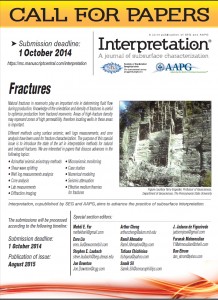 Interpretation
Interpretation
S.E. Laubach joined the editorial board of the SEG-AAPG journal INTERPRETATION.
Laubach is also editing a theme issue on “Fractures”. Manuscripts are due on the 1st of October.
A theme issue on “Geomechanics” is in the planning stages.
Review: Advances in Carbonate Exploration & Reservoir Analysis
Read the review of Geological Society Special Publication 370 in the Geoscientist. The volume was co-edited by SDI researcher Laubach and contains our paper on dolostone fracture diagenesis and scaling (Hooker et al., 2012).
Highly Cited since 2009
Three project papers have been recognized as among the top 25 most highly cited papers since 2009 by the publisher of Journal of Structural Geology.
- Pure and shear-enhanced compaction bands in Aztec Sandstone. Eichhubl, Hooker, Laubach | 2010
- Aperture-size scaling variations in a low-strain opening-mode fracture set, Cozzette Sandstone, Colorado. Hooker, Gale, Gomez, Laubach, Marrett | 2009
- Structural diagenesis. Laubach, Eichhubl, Hilgers, Lander | 2010
Jon Olson promoted to Professor | PGE
Congratulations to Jon Olson on his promotion to full professor. Olson will be on the road as an SPE Distinguished Lecturer in 2014. Contact SPE for Olson’s speaking schedule. Slides are available on the FRAC web site.
2013 Highlights
Olson to deliver SPE Distinguished Lecture Tour 2014-2015

SDI/FRAC Student Event Rescheduled and Research Colloquium Planned
Highly Cited Papers in JSG since 2008
Two project papers have been recognized as among the mostly highly cited since 2008 by the publisher of Journal of Structural Geology.
- Pure and shear-enhanced compaction bands in Aztec Sandstone v. 32/12, December 2010, p. 1873-1886. Eichhubl, P. | Hooker, J.N. | Laubach, S.E.
- Aperture-size scaling variations in a low-strain opening-mode fracture set, Cozzette Sandstone, Colorado v. 31/7, July 2009, p. 707-718. Hooker, J.N. | Gale, J.F.W. | Gomez, L.A. | Laubach, S.E. | Marrett, R.
New Developments in Spatial Scaling
Hottest Downloads 2013
A paper by industry research partner Rick Schultz with co-author J.E. Olson is listed as number 1 on the top 25 list of downloads for the Journal of Structural Geology January to March 2013. Statistical tests of scaling relationships for geologic structures, Journal of Structural Geology, v. 48, March 2013, p. 85-94 | by Schultz, R.A., Klimczak, C., Fossen, H., Olson, J.E., Exner, U., Reeves, D.M., Soliva, R.
Gale AAPG Distinguished Lecture tour
Julia F.W. Gale has been named an AAPG Distinguished Lecturer. Her lectures will describe the SD initiative’s work in shale/mudstone fracture systems worldwide. This recognition marks six distinguished lecture tours by SD initiative scientists that have been sponsored by a professional society (and 7 overall) since initiation of the SDI program | Julia’s slides can be found on the FRAC website | Tour information
Notable Papers 2005-2009
The AAPG Bulletin recently instituted recognition of notable papers published between 2005 to 2009. The top ten list for each year is based in part on a review of citation counts three years after publication of the paper and on content review by the Bulletin’s Editorial Board.
SEG Workshop 2013 | Keynote
AAPG Petroleum Structural Geology & Geomechanics
AAPG Charles Taylor Fellows Lecture
New students in SDI program 2013 | See Dissertation & Thesis
2012 Highlights
Advances in Carbonate Exploration and Reservoir Analysis
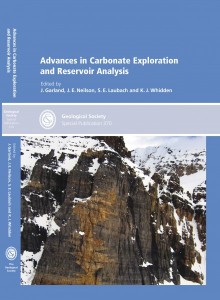
Unconventional Resources Technology Conference
AAPG Distinguished Lecture 2011-12
Calgary CSPG Lecture 2011-12 | Jon Olson’s talk at CSPG
FRAC Marcellus field trip | Field guide & photos
2012 Pratt Award for best paper in the AAPG Bulletin To Rob Lander and Linda Bonnell for their 2010 paper in AAPG Bulletin, vol. 94, p. 1161-1187, entitled A model for fibrous illite nucleation and growth in sandstones. Rob and Linda are co-founders of Geocosm LLC and Research Fellows with the Structural Diagenesis Initiative.
2011 Highlights
2011 Bureau of Economic Geology Publication Award
SD Initiative paper recognized by publisher for top citations
Diagenesis in porosity evolution of opening-mode fractures, Middle Triassic to Lower Jurassic La Boca Formation, NE Mexico by S.E. Laubach and M. Ward
Tectonophysics 419, Issue 1-4 (2006), p. 75-97. | View at Publisher>>
Two SD Initiative papers named in ScienceDirect Top 25 Articles based on downloads
No. 4: Structural diagenesis Journal of Structural Geology, v. 32, no. 12, 2010, p. 1866-1872, Laubach, S.E.; Eichhubl, P.; Hilgers, C.; Lander, R.H.
No. 20: Determining brittle extension and shear strain using fault-length and displacement systematics: Part I: Theory Journal of Structural Geology, v. 32, no. 12, 2010, p. 1960-1977, Twiss, R.J.; Marrett, R
GCAGS Annual Meeting, Veracruz 2011
2010 Highlights
Structural Diagenesis Theme Issue
Laubach Elected AAPG Editor & Member, Executive Committee
Announcing the Stephen E. Laubach Structural Diagenesis Research Award Fund
Underground Science
Conferences | Geological Society of London
The geology of unconventional gas plays, The Geological Society (London), Burlington House, London, October, 2010. S. E. Laubach, Convener.
2009 Highlights
On the cover of the May 2009 issue of AAPG Bulletin
Key Paper in International Coalbed & Shale Gas Symposium
Olson to lead Austin modeling short course
Special Issue of Journal of Structural Geology
2008 Highlights
Structural diagenesis: fracture opening and sealing processes: presented at International Geological Congress, Oslo, Norway, August 2008. S. E. Laubach.
2007 Highlights
AAPG Award of Excellence “Top 10” Oral Presentations for “Structural Complexity in Structurally Simple Fractured Reservoir Analogs,” which was presented at the AAPG Convention, Long Beach, 2007. S. E. Laubach, M. Ward.
Structural Diagenesis Field Symposium, Scotland.
2006 Highlights
Ortega, O. J.†, Marrett, R., and Laubach, S. E., 2006, A scale-independent approach to fracture intensity and average fracture spacing : AAPG Bulletin, v. 90, no. 2 (February 2006), 193-208. AAPG Notable Paper for 2006
2005 Highlights
Philip, Z. G.†, Jennings, J. W., Jr., Olson, J., Laubach, S. E., and Holder, Jon, 2005, Modeling coupled fracture-matrix fluid flow in geomechanically simulated fracture networks: Society of Petroleum Engineers, SPE Reservoir Evaluation & Engineering, v. 8, no. 4, p. 300–309.
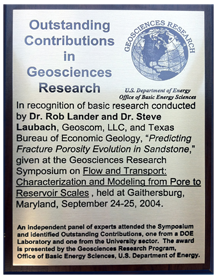
Basic Energy Sciences Award
2004 Highlights
Best university research, presentation at the US Department of Energy Symposium Flow and Transport: from Pore to Reservoir Scales, 2004, R. H. Lander, S. E. Laubach.
Distinguished Lecturer, Society of Petroleum Engineers, 2004, S. E. Laubach.
Hedberg Research Conference, Structural Diagenesis, American Association of Petroleum Geologists, Austin, Texas, 2004. S. E. Laubach, J. Olson, R. H. Lander.
2003 Highlights
Practical Approaches to Identifying Sealed and Open Fractures, 2003, AAPG Bulletin, v. 87, no. 4, p. 561–579, S. E. Laubach.
- 2006 | Selected for Understanding Diagenetic Controls on Sandstone Reservoir Quality: A Compendium of Influential Papers,
- 2008 | Selected for Fractured Reservoirs: A Compendium of Influential Papers; AAPG Getting Started Series.



